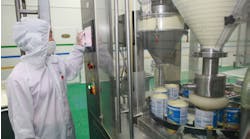[pullquote]“Don’t put them in a fluid bed.” I often hear this comment about sticky solids from plant operators and engineers because they’ve had many bad experiences with fluid beds. They end up spending countless hours cleaning out a plugged distributor, opening a discharge chute or banging on the vessel to get the solids to flow. They say the solids are too sticky to fluidize. Let’s face it: sticky solids need special attention. But first, we must identify the source of the stickiness.
Almost all fine solids, when wet, are sticky. Many others clump due to a variety of factors including stickiness (see: “Clamp Down on Clumping”). Only a few of those factors come into play in the operation of a fluid bed; the leading issue is the solvent, usually water. In my mind, melting of the particulate solids is the only legitimate excuse for plugging a fluid bed. So, what are the real causes of pluggage and how can you prevent them? The problem mainly arises on the fluidizing plate, screen or grid. The failure often stems from poor dispersion of the solids, lack of enough bed depth, low velocity through the grid and spacing the holes in the grid too far apart, as the following examples show:
• In one dryer project, a centrifuge had been placed above the dryer to eliminate the need for a screw feeder. Unfortunately, if the centrifuge was over-fed, slurry dropped onto the dryer grid. The grid had tuyeres designed for a catalytic cracker instead of a dryer. These were replaced with a more-robust design while retaining the tuyere spacing. The increase in velocity and horizontal gas flow tolerated the occasional centrifuge upsets, which were reduced by better instrumentation. The benefits of the new grid design didn’t stop there. The dryer product had a more-uniform moisture content, partially due to the greater heat transfer to the solids. Later, thanks to the change in grid design, the plant was able to raise the capacity of the dryer.
[callToAction ]
• On a second project, the plant engineers were painfully aware of the stickiness of their product; it plugged up the centrifuge discharge on a regular basis. Also, the moisture content was higher than normally encountered in a fluid bed. The solution was to install a high-speed mill above the dryer even though the solids already were finer than the mill could produce. It dispersed the solids over the bed without attriting the particles. The fluid bed was split into zones, with the first very deep. This design allowed the particles to flash off the free moisture and eliminate the normally sticky surface. The deep bed required more pressure drop across the grid to ensure uniform distribution of the solids and to keep them off the grid. In addition, the higher pressure-drop requirement called for smaller grid holes that were spaced closer together to avoid hot spots.
• Another project involved a dryer suffering excessive entrainment after a recent product change presented a finer material to it. The corporate health and safety group had mandated a minimum velocity through the fluid bed of 3 ft/s for this product — due to frequent fires in the dryer when the velocity was below 3 ft/s, even though the solids could be fluidized easily at 1 ft/s. I replaced the grid with one that had the same pressure drop at 1 ft/s as the old one had at 3 ft/s. The lower velocity in the bed reduced the entrainment while the higher velocity through the grid kept the solids from sticking to the grid and burning. It also improved the heat transfer and evaporation rate, enabling the dryer to maintain the same production rate despite the lower fluidization velocity.
The secret to putting particulate solids into a fluid bed successfully (which means getting them out in one piece) is close attention to dispersion of the solids, good bed depth, and careful design of the fluidization grid. It’s amazing how many other good things happen when you properly put sticky solids into a fluidized bed.



